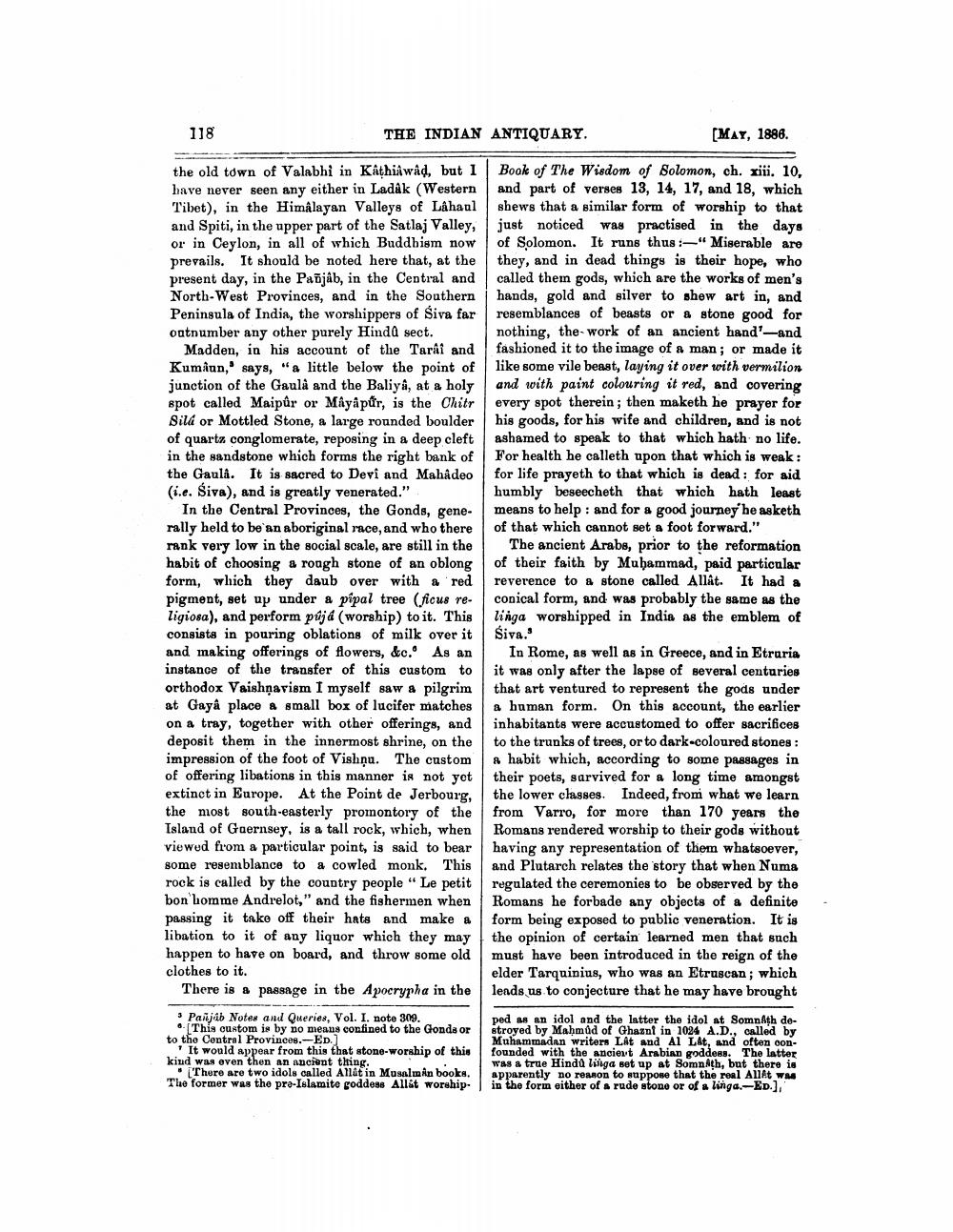________________
118
THE INDIAN ANTIQUARY.
[MAY, 1886.
the old town of Valabhi in Kathiawad, but I Book of The Wisdom of Solomon, ch. xiii. 10, have never seen any either in Ladak (Western and part of verses 13, 14, 17, and 18, which Tibet), in the Himalayan Valleys of Lâhaul shews that a similar form of worship to that and Spiti, in the upper part of the Satlaj Valley, just noticed was practised in the days or in Ceylon, in all of which Buddhism now of Solomon. It runs thus:-"Miserable are prevails. It should be noted here that, at the they, and in dead things is their hope, who present day, in the Paõjab, in the Central and called them gods, which are the works of men's North-West Provinces, and in the Southern hands, gold and silver to shew art in, and Peninsula of India, the worshippers of Siva far resemblances of beasts or a stone good for outnumber any other purely Hind sect. nothing, the work of an ancient hand'-and
Madden, in his account of the Tarai and fashioned it to the image of a man; or made it Kumaan," says, "a little below the point of like some vile beast, laying it over with vermilion junction of the Gaulà and the Baliya, at a holy and with paint colouring it red, and covering spot called Maipúr or Mayapür, is the Chitr every spot therein; then maketh he prayer for Sild or Mottled Stone, a large rounded boulder his goods, for his wife and children, and is not of quartz conglomerate, reposing in a deep cleft ashamed to speak to that which hath no life. in the sandstone which forms the right bank of For health he calleth upon that which is weak: the Gaula. It is sacred to Devi and Mahadeo for life prayeth to that which is dead: for aid (ie. Siva), and is greatly venerated."
humbly beseecheth that which hath least In the Central Provinces, the Gonds, gene- means to help : and for a good journey' he asketh rally held to be an aboriginal race, and who there of that which cannot set a foot forward." rank very low in the social scale, are still in the The ancient Arabs, prior to the reformation habit of choosing a roagh stone of an oblong of their faith by Muhammad, paid particular form, which they daub over with a red reverence to a stone called Allåt. It had a pigment, set up under a pípal tree (ficus re- conical form, and was probably the same as the ligiosa), and perform půjd (worship) to it. This | linga worshipped in India as the emblem of consists in pouring oblations of milk over it Siva. and making offerings of flowers, &c. As an In Rome, as well as in Greece, and in Etruria instance of the transfer of this custom to it was only after the lapse of several centuries orthodox Vaishnavism I myself saw a pilgrim that art ventured to represent the gods under at Gaya place a small box of lucifer matches a human form. On this account, the earlier on a tray, together with other offerings, and | inhabitants were accustomed to offer sacrifices deposit them in the innermost shrine, on the to the trunks of trees, or to dark-coloured stones: impression of the foot of Vishņu. The custom habit which, according to some passages in of offering libations in this manner is not yet their poets, sarvived for a long time amongst extinct in Europe. At the point de Jerbourg, the lower classes. Indeed, from what we learn the most south-easterly promontory of the from Varro, for more than 170 years the Island of Gaernsey, is a tall rock, which, when Romans rendered worship to their gods without viewed from a particular point, is said to bear having any representation of them whatsoever, some resemblance to a cowled monk. This and Plutarch relates the story that when Numa rock is called by the country people "Le petit regulated the ceremonies to be observed by the bon homme Andrelot," and the fishermen when Romans he forbade any objects of a definite passing it take off their hats and make a form being exposed to public veneration. It is libation to it of any liquor which they may the opinion of certain learned men that such happen to have on board, and throw some old must have been introduced in the reign of the clothes to it.
elder Tarquinius, who was an Etruscan; which There is a passage in the Apocrypha in the lends us to conjecture that he may have brought Panjib Notes and Queries, Vol. I. note 309.
ped as an idol and the latter the idol at SomnAth de6.This custom is by no meang confined to the Gonds or stroyed by Mahmud of Ghaznt in 1024 A.D., called by to the Control Provinces.-ED]
Muhammadan writers Let and Al Lat, and often oonIt would appear from this that stone-worship of this founded with the ancient Arabian goddess. The latter kind was even then an ancient thing.
was a true Hindu liiga set up at Somnath, but there is [There are two idols called Alldt in Musalman books.
apparently no reason to suppose that the real Alat was The former was the pre-Islamite goddess Allot worship in the form either of a rude stone or of a linga.-ED,




